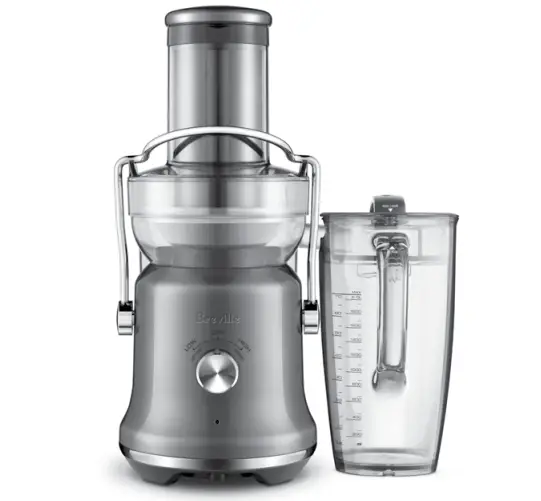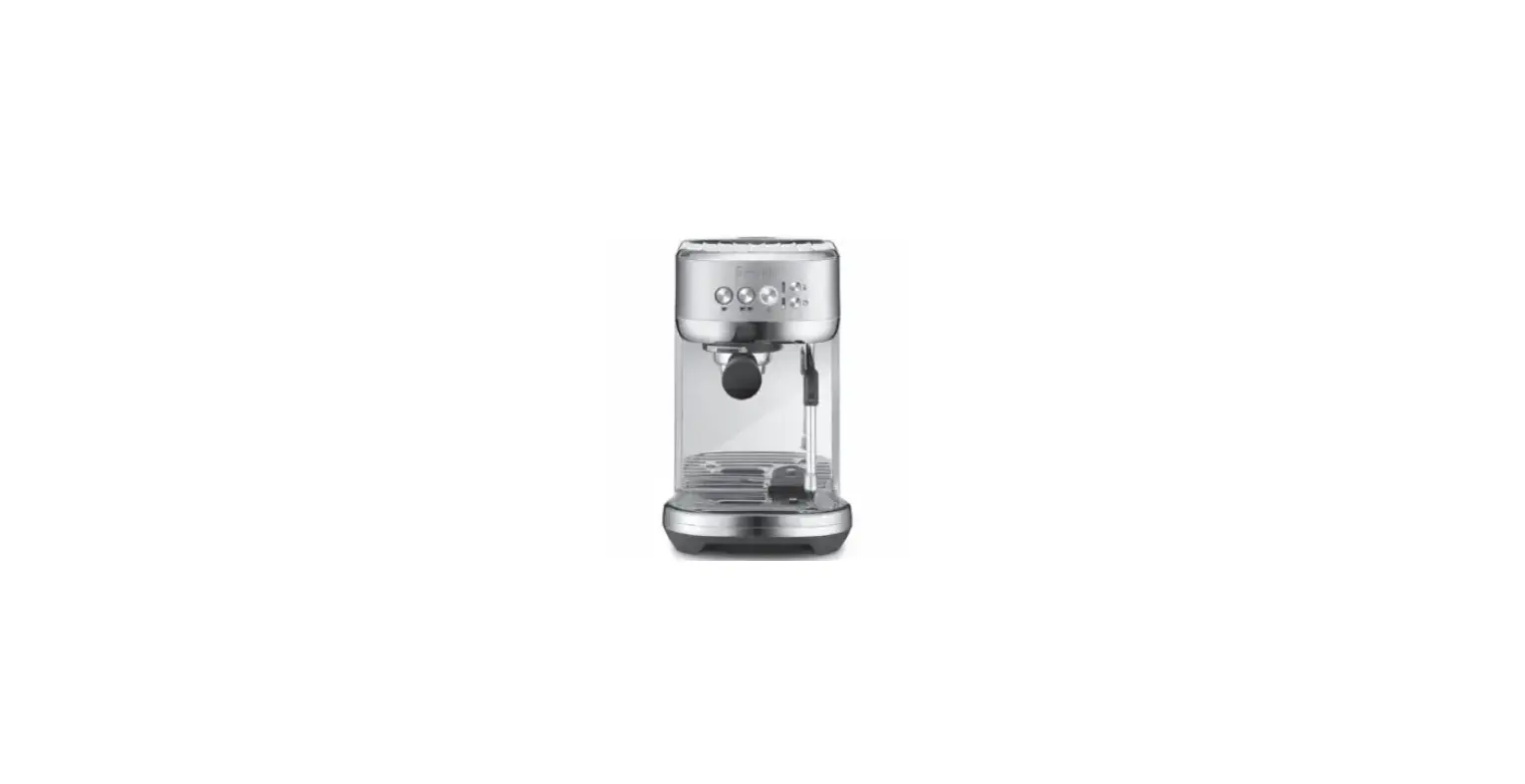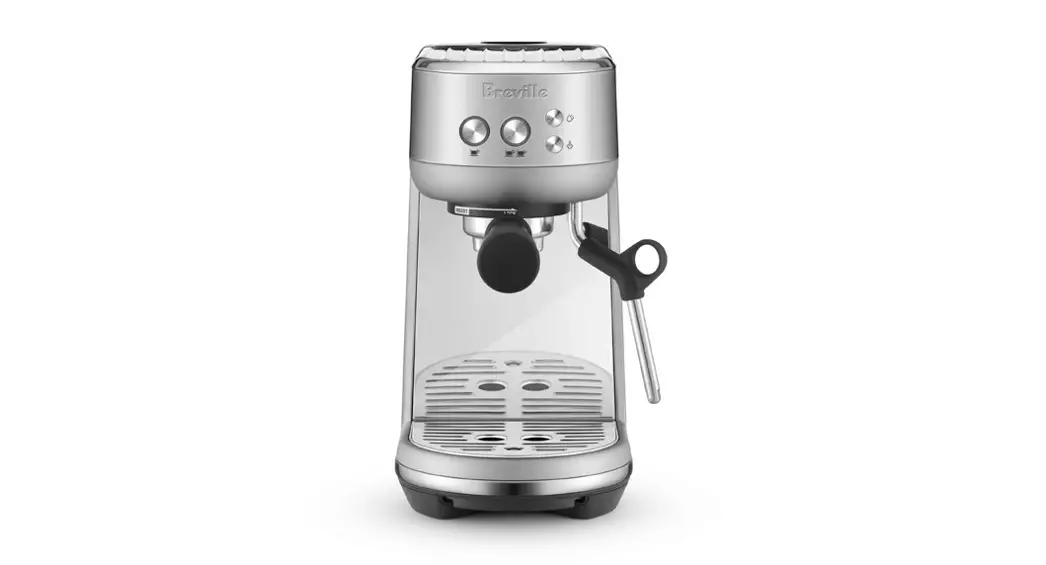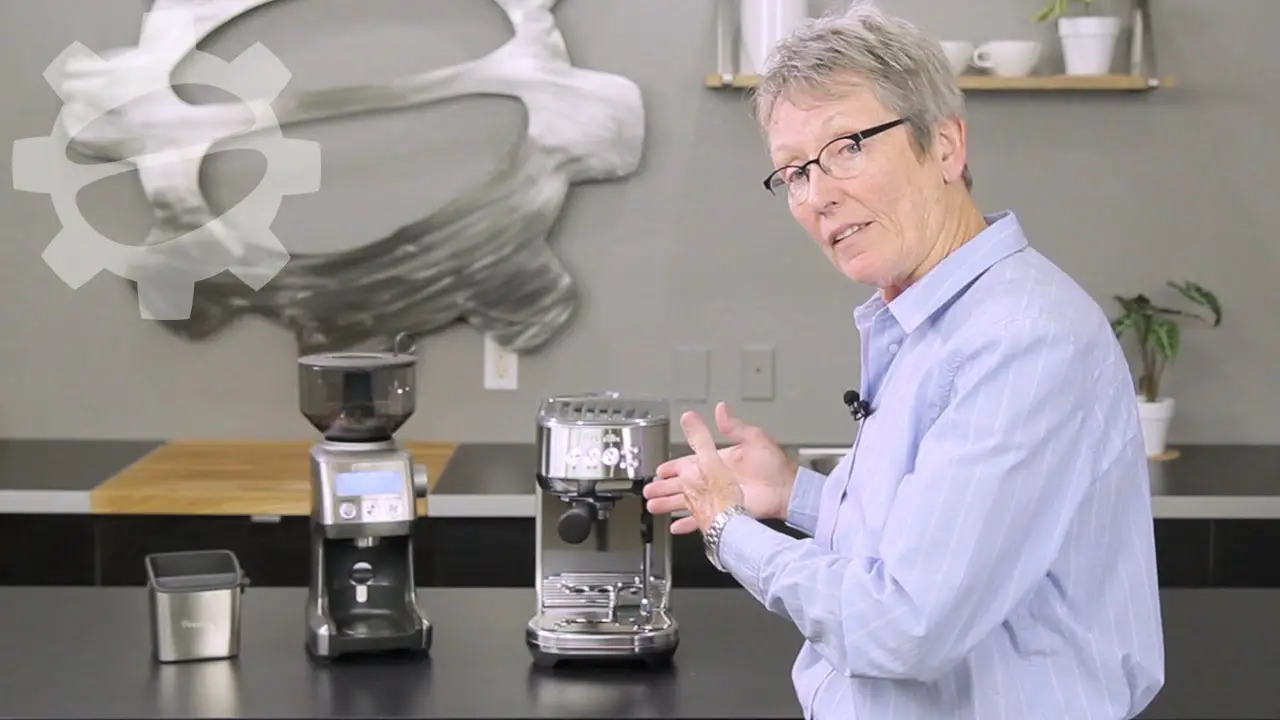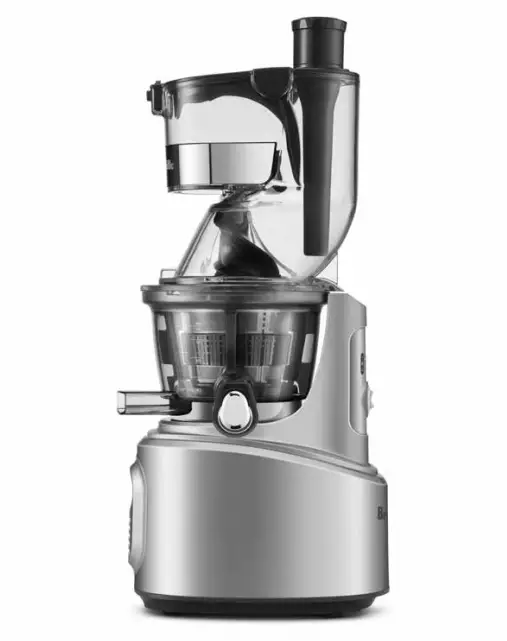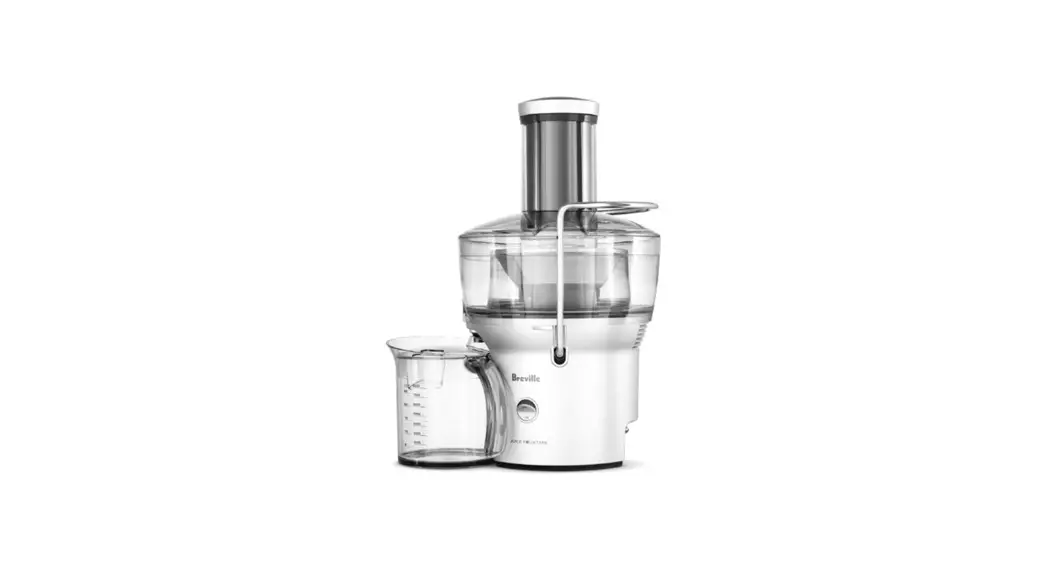the Juice Fountain‰Cold Plus

BREVILLE RECOMMENDS SAFETY FIRST
At Breville we are very safety conscious. We design and manufacture consumer products with the safety of you, our valued customer, foremost in mind. In addition we ask that you exercise a degree of care when using any electrical appliance and adhere to the following precautions.
IMPORTANT SAFEGUARDS
READ ALL INSTRUCTIONS BEFORE USE AND SAVE FOR FUTURE REFERENCE:
- Remove and safely discard any packaging material or promotional labels before using the juicer for the first time.
- To eliminate a choking hazard for young children, remove and safely discard the protective cover fitted to the power plug of this appliance.
- Do not place the juicer near the edge of a bench or table during operation. Ensure that the surface is level, clean and free of water, flour, etc. Vibration during operation may cause the appliance to move.
- Do not place the juicer on or near a hot gas or electric burner, or where it could touch a heated oven.
- Do not use the juicer on a sink drain board.
- Any significant spillage onto the surface under or around the appliance, or onto the appliance itself, should be cleaned and dried before continuing to use the appliance.
- Always ensure the juicer is properly assembled before use. The appliance will not operate unless properly assembled.
- Always make sure juicer cover is clamped securely in place before motor is turned on. Do not unfasten locking bar while juicer is in operation.
- Do not use the appliance if the rotating filter basket or lid is damaged.
- Remove rind from all citrus fruit before juicing.
- Ensure that the seed is removed before juicing stone fruit.
- Keep hands, fingers, hair, clothing as well as spatulas and other utensils away from the appliance during operation.
- Do not push food into the feed chute with your fingers or other utensils. Always use the food pusher provided. Do not place hand or fingers into the food chute when it is attached to the appliance.
- Do not leave the juicer unattended when in use
- Always ensure the juicer is turned off by turning the dial on the control panel to OFF. Then switch the appliance off at the power outlet and unplug the cord. Make sure the filter basket has stopped rotating and the
motor has completely stopped before releasing the safety locking arm and/or attemptingto move the appliance, when the juicer is not in use,
and before disassembling, cleaning and storing. - A representative example of the heaviest loading anticipated for use with this juicer is 5kg of beetroot, juiced continuously over a period of 2 minutes.
- Hard fruits and vegetables will put excess strain onto the motor if low speed is selected. Please refer to the juicing guide to determine the
correct speed for the fruits and vegetables selected for juicing. - Allow the motor to rest for 1 minute between each use.
- Keep the appliance clean. Refer to care and cleaning section of this manual.
- Be careful when handling the filter basket as the small cutting blades at the base of the filter basket are very sharp. Mishandling may cause injury
- Do not use the juicer for anything other than food and/ or beverage preparation.
- Authorised Breville Service Centres can be found on our website
www.Breville.com.au Alternatively, you can contact the Breville Customer Care Centre by phone on 1300 139 798 or email
[email protected]
IMPORTANT SAFEGUARDS FOR ALL ELECTRICAL APPLIANCES
- Fully unwind the power cord before use.
- Do not let the power cord hang over the edge of a bench or table, touch hot surfaces or become knotted.
- To protect against electric shock do not immerse the power cord, power plug or appliance in water or any other liquid.
- Always disconnect the appliance from the supply if it is left unattended
and before assembling, disassembling or cleaning. - This appliance shall not be used by children. Keep the appliance and its cord out of reach of children. Appliances can be used by persons with reduced physical, sensory or mental capabilities or lack of experience
and knowledge if they have been given supervision or instruction concerning use of the appliance in a safe way and if they understand the hazards involved. - Children should be supervised to ensure that they do not play with the appliance.
- Cleaning and user maintenance shall not be made by children without supervision.
- It is recommended to regularly inspect the appliance. To avoid a hazard do not use the appliance if power cord, power plug or appliance becomes damaged in any way. Return the entire appliance to the nearest authorised Breville Service Centre for examination and/or repair.
- Any maintenance other than cleaning should be performed at an authorised Breville Service Centre.
- This appliance is for household use only. Do not use this appliance for anything other than its intended use. Do not use in moving vehicles or boats. Do not use outdoors.
Misuse may cause injury. - The installation of a residual current device (safety switch) is recommended to provide additional safety protection when using electrical appliances. It is advisable that a safety switch with a rated residual operating current not exceeding 30mA be installed in the electrical circuit supplying the appliance. See your electrician for professional advice.
 WARNING
WARNING 
In order to avoid the possible hazard of the juicer starting by itself due to inadvertent resetting of the overload protection, do not attach an external switching device (such as a timer) or connect the juicer to a circuit that can regularly switch the appliance on and off.
FOR HOUSEHOLD USE ONLY SAVE THESE INSTRUCTIONS
 Components
Components 

A. Food pusher (not dishwasher safe)
B. Interlocking safety arm Stops juicer operating without cover locked into place.
C. Juicer cover (dishwasher safe)
D. Stainless steel filter basket (dishwasher safe)
E. Pulp container (dishwasher safe)
F. Filter bowl surround (dishwasher safe)
G. 2 Speed control and off dial
H. Overload protection indicator light I. 2 litre juice jug and sealing lid with built in froth separator (dishwasher safe)
J. Juicing Nozzle (dishwasher safe) Can be placed over spout to juice directly into a cup.
 Assembly
Assembly 
BEFORE FIRST USE
Before using your juicer for the first time, remove and safely discard any packaging materials and promotional stickers and labels.
Ensure the power cord is unplugged. Wash the filter bowl surround, filter basket, juicer cover, food pusher, pulp container and juice jug and lid in warm, soapy water with a soft cloth. Rinse and dry thoroughly.
- Place motor base on a flat, dry surface such as a countertop. Ensure that the juicer is switched to OFF at the dial, and the power cord is unplugged.
- Place filter bowl surround on top of the motor base.

- Align the arrows at the base of the stainless steel filter basket with the arrows on the motor drive coupling and push down until it clicks into place to create a secure fit with the motor base.

- Place the juicer cover over the filter bowl surround, positioning the lower part of the feed chute over the stainless steel filter basket.

- Raise the safety locking arm up and locate into the two grooves on either side of the juicer cover.

- The safety locking arm should now be in a vertical position and locked into place on top of the juicer cover.

- Slide the food pusher down the food chute by aligning the groove in the food pusher, with the small protrusion on the inside of the top of the feed tube.

- Place the pulp container into position by tilting and lifting the motor base slightly. Insert the pulp container under the juicer cover on the back ensuring it is supported by the juicer cover and motor base.
- Fit the lid to the juice jug and position jug under juice spout.
JUICE JUG
Juice can be preserved in the juice jug for up to 3 days by following these steps.

- Lift the lid off the jug and rotate 180°
- Press down firmly to replace the lid
- Store juice in the fridge
NOTE: Storage time depends on the ingredients being juiced and the freshness of the fruit prior to juicing. Juice must be stored in the refrigerator between 2°C to 4°C.
 Functions
Functions 
- Wash your selection of fruit and vegetables to be juiced. Most fruit and vegetables such as apples, carrots and cucumbers will not need to be cut or trimmed to size as these will fit whole into the feed chute. Ensure vegetables such as beets, carrots etc. have all soil removed, are washed well and trimmed of leaves before using.
- Plug the power cord into a 240V power outlet.
IMPORTANT: Do not load Feed Chute with produce before the Juicer has reached the selected speed. - Turning the Juicer On Turn dial to desired speed setting. Turn Dial to “Low” setting for soft fruits and vegetables and to “High” setting for hard fruits and vegetables. See Speed Selector Guide table on the next page to match speed and produce type for maximum yield. “Low” range, while it may not maximise yield of some produce, allows you to extract juice at a significantly lower noise.
- With the motor running, place food into the feed chute and use the food pusher to gently guide food down. To extract the maximum amount of juice, always push the food pusher down slowly.
- Full Juice Jug You can keep juicing until the Juice Jug is filled to max. level.
- Continuous Juicing Having just filled and removed a Juice Jug with fresh juice, you can place an empty Juice Jug back onto the nozzle and continue juicing without disassembly. When the Pulp Container is near full with pulp, turn the Dial to “Off”, remove the Pulp Container only and empty contents. Replace the empty Pulp Container and turn Dial to desired speed selection to continue juicing.
SPEED SELECTOR GUIDE
FOOD TYPE SPEED
APPLES High
BABY SPINACH High
BEETS High
BELL PEPPER High
BLUEBERRIES High
BROCCOLI High
CABBAGE High
CARROT High
CELERY High
CITRUS FRUITS (peeled) Low
CUCUMBER High
GINGER High
GRAPES (seedless) Low
HONEYDEW MELON (peeled) High
KALE High
KIWI (peeled) Low
MANGO (peeled, pit removed) High
MINT High
PEACH (pit removed) High
PEARS High
PINEAPPLE (peeled) High
RHUBARB High
SQUASH High
STRAWBERRIES High
TOMATOES High
WATERMELON (peeled) Low
ZUCCHINI High
NOTE:
- Do not allow the pulp container to overfill as this may affect the operation of the appliance.
- The juicer is fitted with a safety device which safeguards against overheating with excessive loads. If overheating occurs, the juicer will automatically activate the overload protection device and the unit will switch itself off. When the overload protection is activated, unplug the juicer from the power outlet for 30 minutes to allow the unit to cool. Then plug juicer into the power outlet and use as normal.
WARNING:
Never use fingers, hands or utensils to push food down the feed chute or to clear the feed chute. Always use the food pusher provided.

The stainless steel filter basket contains small sharp blades to cut and process fruit and vegetables. Avoid touching the blades when handling the filter basket.
 Care & Cleaning
Care & Cleaning 
Ensure the juicer is turned off by turning the juicer dial to the OFF position. Then unplug the power cord.
CLEANING
- Remove Juice Jug.
- Remove Pulp Container.
- Disengage Locking Bar, pull up entire Juice Collector Assembly and take to sink.
Rinse all parts after use (except the motor base) under running water to clear away the majority of juice and pulp. Wash in warm soapy water with a soft cloth.
To avoid food drying on to the blades, mesh or transparent parts, rinse and wash as soon as possible after use.
PULP CONTAINER
To minimize cleaning, you can line the pulp container with a biodegradable bag to collect the pulp.
MOTOR BASE
To clean the motor base, wipe with a soft, damp cloth then dry thoroughly. Wipe any excess food particles from the power cord.
Do not immerse the motor base in liquids.
CLEANING AGENTS
Do not use abrasive scouring pads or cleaners on either the motor base or the jug, as they may scratch the surface. Use only warm soapy water with a soft cloth.
DISHWASHER
Wash all parts (except the motor base) in warm soapy water with a soft cloth.
All parts except for the motor base and food pusher are dishwasher safe.
However washing parts on a regular base in the dishwasher can shorten the life of them due to prolonged exposure to harsh detergents, hot water and pressure.
Cleaning the parts in the dishwasher also may cause parts to deteriorate so inspect the parts regularly and stop using the product if any signs of damage is noticed. Cleaning the parts in the dishwasher also may cause parts to deteriorate so inspect the parts regularly and stop using the product if any signs of damage is noticed.
FILTER BASKET
To ensure consistent juicing results, always clean the filter basket thoroughly
immediately after use. If pulp is left to dry, it may clog the fine pores of the filter mesh, which can affect juicing performance. The filter basket can be soaked in hot soapy water for 10 minutes, if necessary.
Hold the filter basket under running water and use brush (supplied with the juicer) in a circular motion to clear away pulp from the inside of the basket, including the blades. Turn over to brush away pulp from the outside of the basket, and repeat if necessary.
After cleaning, hold up towards a light source to check that the fine mesh pores are not blocked. If blocked, soak the filter basket in hot water with 10% lemon juice to loosen, and brush under running water again.
Do not soak the filter basket in bleach, harsh chemicals or abrasive cleansers.
Always treat the filter basket with care, as it can be easily damaged. Do not use if there is any damage or deformation to the filter mesh.
Filter basket can be washed in the dishwasher (top shelf).
The center of the filter basket has an array of small, sharp blades. Do not touch these blades when handling the filter basket.
STUBBORN FOOD STAINS
Discoloration of the plastic may occur with strongly colored fruit and vegetables. To help prevent this, wash parts immediately after use.
If discoloration does occur, the plastic parts can be soaked in water with 10% lemon juice or can be cleaned with a non-abrasive cleaner.
 Troubleshooting
Troubleshooting 
Juicer will not work when switched ON:
- The safety locking arm may not be correctly engaged in the vertical operating position. Check the top cover is properly aligned and the locking arm is located firmly into the two grooves on either side of the juicer cover.
- Motor overload protection may have operated (see below).
Overheating with excessive loads:
- The juicer is equipped with an internal self-resetting overload to prevent the motor from damage under heavy or continuous loads. If the motor suddenly stops working, turn the dial to OFF, and unplug the unit from the power outlet.
Allow the juicer to cool for at least 30 minutes before operating again. NOTE: The unit MUST be turned off in order for it to cool and be reset. - Despite this overload protector, we suggest juicing in smaller batches, without excessive pushing force, to avoid overheating and stalling and to maintain the life of the motor.
Excess pulp building up in the stainless steel filter basket :
- Stop juicing, disassemble to scoop excess pulp off the juicer cover. Reassemble and continue juicing. Alternating soft and hard ingredients may help avoid this.
Pulp too wet and reduced extracted juice:
- The cleaner the filter, the better the juice yield, and dryer the pulp. Be sure to thoroughly clean the juicer as soon as possible after each use. Remove the stainless steel filter basket and thoroughly clean mesh walls with a cleaning brush. Rinse the filter basket under hot water. If the fine mesh holes are blocked, soak the basket in a solution of hot water with 10% lemon juice to unblock the holes or wash in the dishwasher (top shelf). This will remove excess fiber build up which could be inhibiting the flow.
Juice leaks between the rim of the juicer and the juicer cover:
- Try a slower juicing speed (if possible) and push the food pusher down the feed chute more slowly.
Juice sprays out from spout:
- The juice is being extracted too High; try a slower juicing speed (if possible) and push the food pusher down the feed chute more slowly.
Motor appears to stall when overload protection LED flashes:
- Wet pulp can build up under the juicer cover and stall the juicer if the juicer is used excessively without cleaning. If this occurs, disassemble and follow the cleaning instructions to clean the filter bowl surround, the stainless steel filterbasket and the juicer cover. The juicer can also stall if excessive force is used to push produce down the feed chute. If this occurs, ensure that a more gentle pressure is used to push produce down the chute.
- The juicer will automatically stop operating if too much food is being processed at one time. Try processing a smaller amount per batch. To continue juicing, reset the juicer by turning the juicer OFF and back ON.
- Turn on the juicer before putting ingredients in the chute. Pressing ingredients down before the juicer reaches full speed can cause the motor to stall or overload. Use gentle to moderate pressure on the pusher. Lower pressure produces a better juice yield.
- Hard fruit and vegetables will put excess strain onto the motor if a low speed is selected. Refer to the juicing guide to determine the correct speed for the fruit and vegetables selected for juicing. Overload protection
LED light flashing during the use:
- This indicates the motor speed is slowed down to an inefficient level. This may be caused by excessive pushing force on the pusher or too much pulp building up on the lid or in pulp pin. Use moderate pushing force on the food pusher and regularly clean the lid and pulp bin to ensure the juicer is operating at optimal speed.
Overload Protection LED is on:
- This indicates motor overload protection is activated. To reset the unit, turn the dial to OFF, unplug the juicer and let the motor cool down for 25–30 minutes, then plug the juicer back in.
If any of the above issues persist, or if you have questions, stop use of the juicer and contact Breville Customer Service.
 Tips
Tips 
THE INSIDE INFORMATION ON JUICING
Fresh fruit and vegetable juices are an excellent source of vitamins and minerals.
When you make your own fruit and vegetable juices, you have complete control over what is included.
PREPARATION OF FRUITS AND VEGETABLES
Fruits with hard or inedible skins should be peeled before juicing, including mangoes, guavas, melons, etc.
Some vegetables, such as cucumbers can be processed unpeeled depending on the softness of the skin and whether you like the taste of the skin in your juice.
Fruits with hard seeds or pits must be pitted before juicing, including nectarines, peaches, mangoes, plums, cherries, as the skin and pith can make the juice bitter.
Citrus fruits with thick pith or skin should be peeled before juicing, including oranges, lemons, mandarins, etc.
Trim leaves and wash vegetables to remove earth/soil, including carrots, beet, spinach, etc.
Trim, hull and remove stalks before juicing, including strawberries, apples, pears, etc.
A small amount of lemon juice can be added to apple juice to reduce browning
THE RIGHT TECHNIQUE
When juicing a variety of ingredients with varying textures, start with the softer texture ingredients on the LOW speed and then change to the HIGH speed for the harder textured ingredients.
If you are juicing herbs, sprouts or other leafy green vegetables, either wrap them together to form a bundle and alternate with more solid ingredients for the best extraction.
Fruits and vegetables produce different amounts of liquids, and can vary between batches or at different times of year. Juice recipes are not exact, so therefore the precise quantities of any juice are not crucial to the success of a particular mixture.
To extract the maximum amount of juice always push the food pusher down slowly.
Allow the motor to reach full speed before putting ingredients in the chute. Pressing ingredients down before the juicer reaches full speed can cause the motor to stall or overload. Use gentle to moderate pressure on the pusher. Lower pressure produces a better juice yield.
USING THE PULP
The remaining pulp left after juicing fruit and vegetables is mostly fiber and cellulose which, like the nutrients in juice, are necessary for the daily diet and can be used in many ways.
Vegetable pulp can be used to add bulk to rissole mixtures, thicken casseroles or soups.
Fruit pulp can be placed in a heat proof bowl, topped with meringue, and baked in the oven for a simple dessert.
When using the pulp, there may be some pieces of fruit or vegetables remaining.
These should be removed before using the pulp in any recipes.
Apart from consumption use, pulp can also be used to create compost for the garden.
Breville Customer Service Centre
Australian Customers
Phone: 1300 139 798
Web: www.breville.com.au
New Zealand Customers
Phone: 0800 273 845
Web: www.breville.co.nz
Breville BJE530 Juice Fountain Cold Plus Juicer Machine Instruction Manual – Optimized PDF
Breville BJE530 Juice Fountain Cold Plus Juicer Machine Instruction Manual – Original PDF
